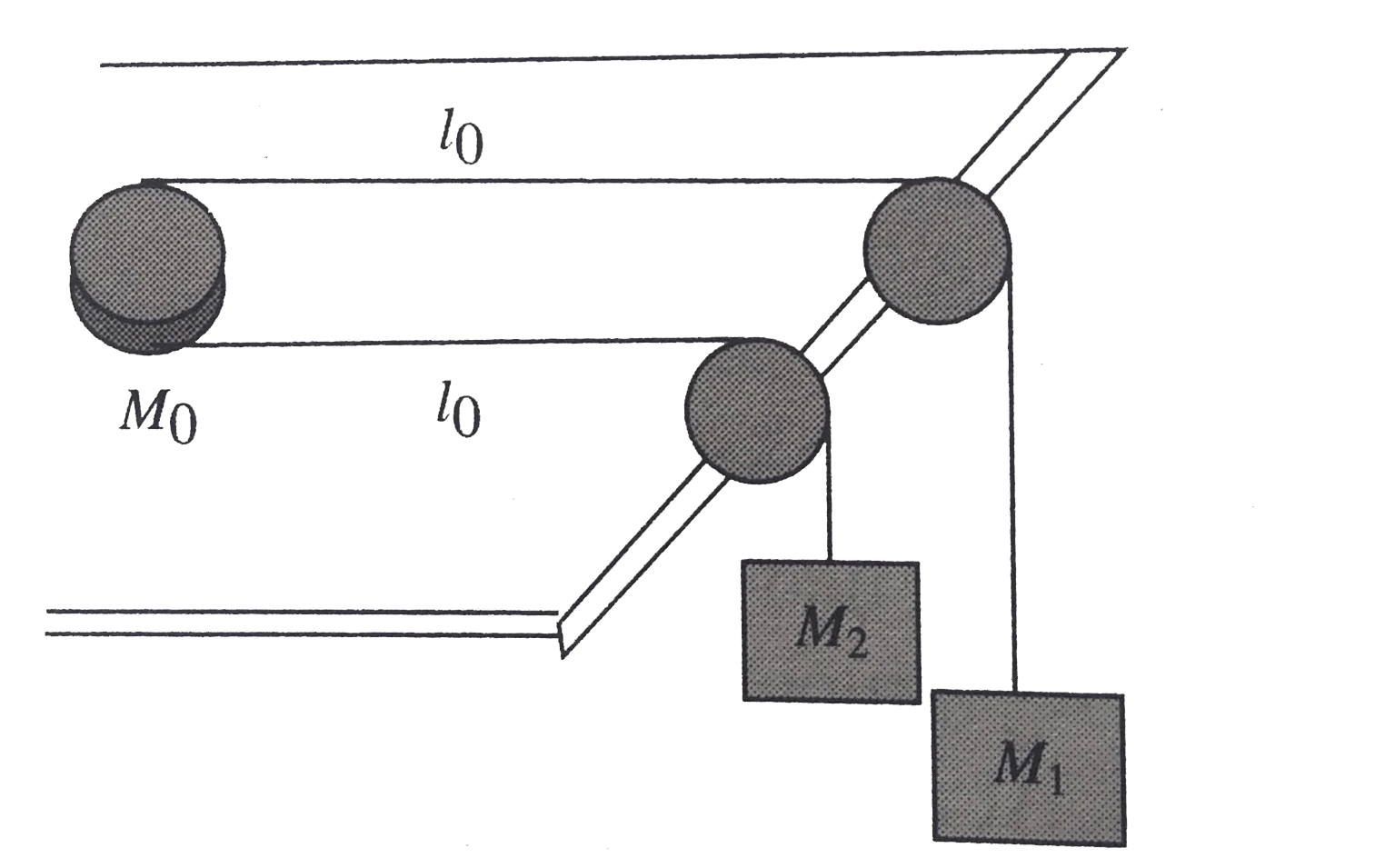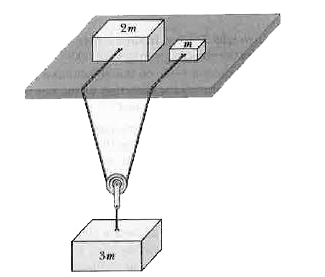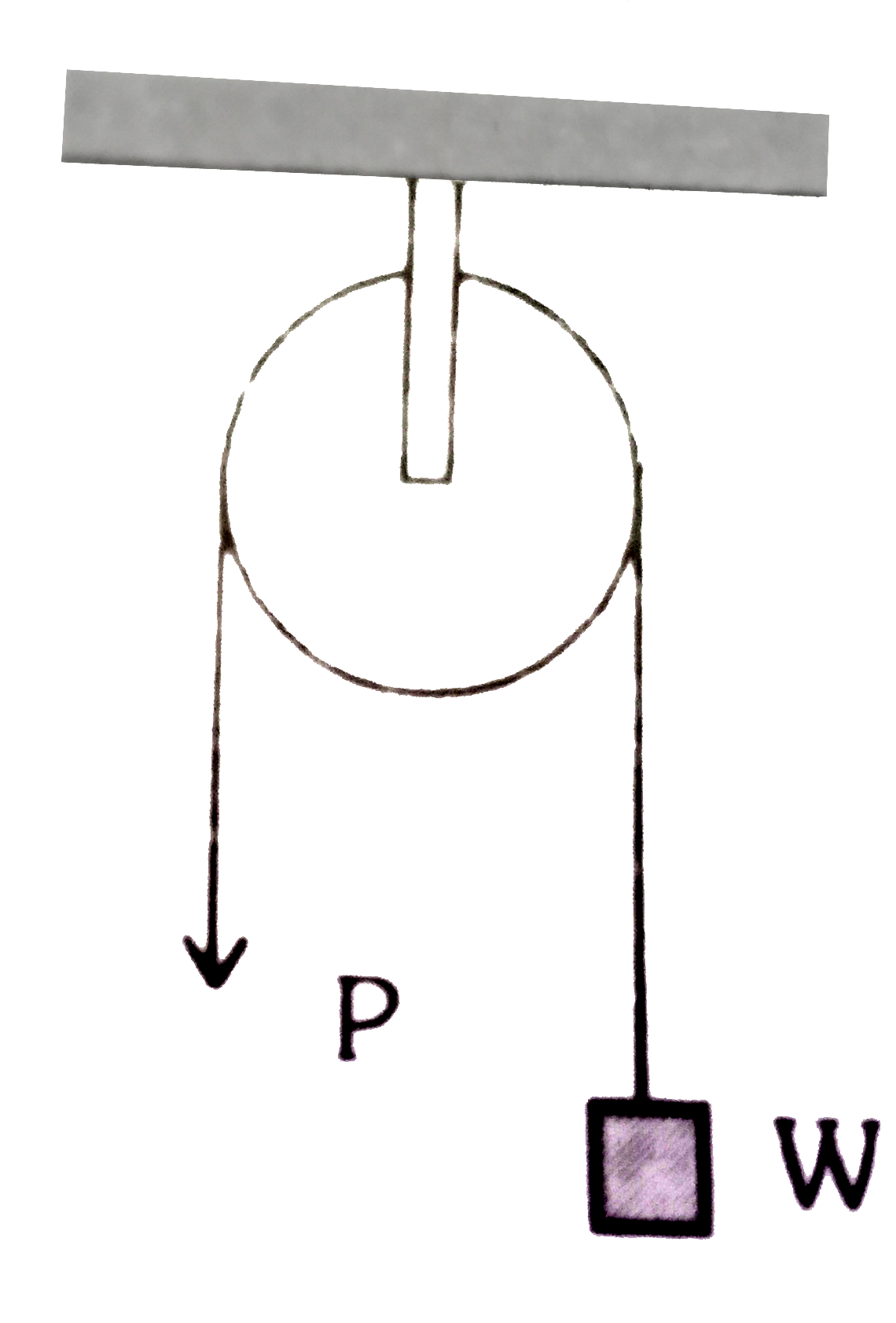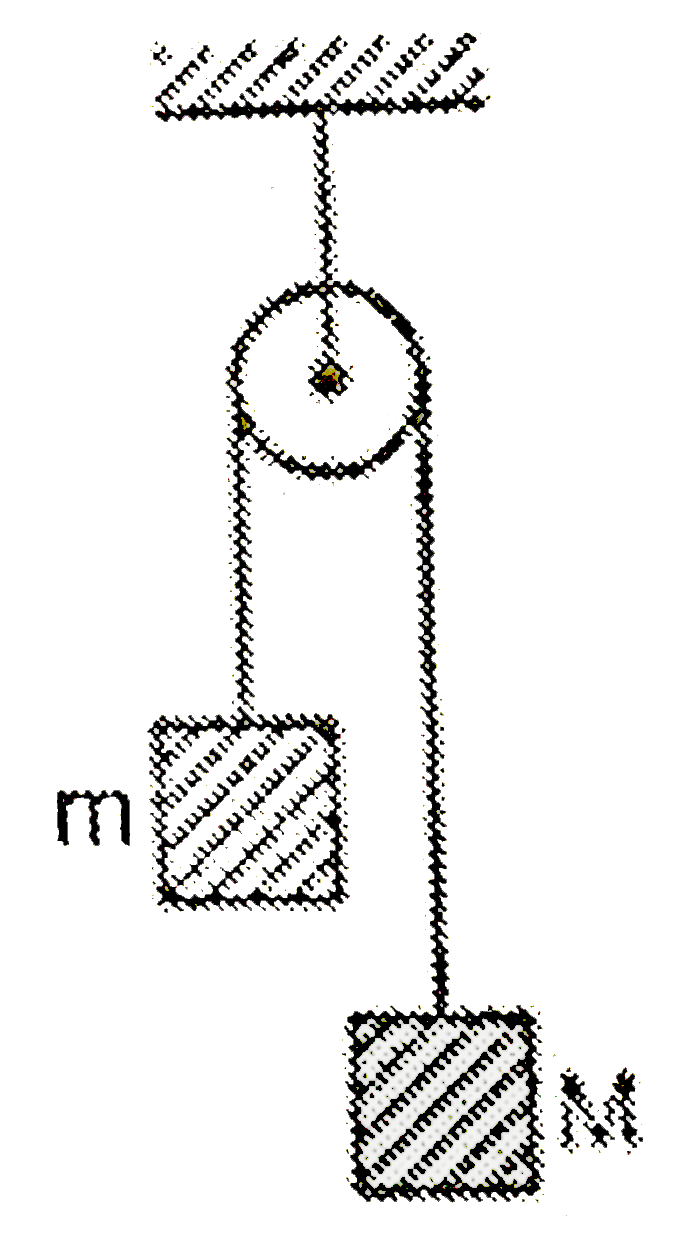A smooth pulley A of mass M0 is lying on a smooth table. A light string passes round the pulley and has masses M1andM2 attached to its ends , the two portion of the string being perpendicular to the edge of the table so that the masses hang vertically . Calculate the acceleration of the pulley .
Let the length of portions of string on the table be l0,l1andl2 as shown in figure .
Let mass M0 move to the right by x on the table , M1 goes down by y1andM2 goes up by y2 .
Then l0 becomes (l0−x),l1 becomes (l1+y1)andl2 becomes (l2−y2).
As the length of string remains unchanged
2l0+l1+l2=2(l0−x)+l1+y1+l2−y2
or 2x=y1−y2
Diff. twice w.r. to t,
we get 2d2xdt2=d2y1dt2−d2y2dt2
If a0,a1anda2 are acceleration of

M0,M1andM2 respectively , then
2a0=a1−a2 ......... (1)
For motion of M0,2T=M0a0 ....... (2)
M1g−T=M1a1....... (3)
For motion of mass M2 ,
T−m2g=M2a2 .......... (4)
Substituting values of a0,a1anda2 from (2) , (3) and (4) in equation (1) , we get
2(2TM0)=(g−TM1)−(TM2−g),
4TM0=2g−T(1M1+1M2)i.e.,(4M0+1M1+1M2)T=2g
This gives T=2M0M1M2g4M1M2+M0(M1+M2)........ (5)
∴ Acceleration of puelly A from (2)
a0=2TM0=4M1M2g4M1M2+M0(M1+M2) ............ (6)
Topper's Solved these Questions
- LAWS OF MOTIONBOOK - AAKASH SERIESCHAPTER - LAWS OF MOTIONEXERCISE - LONG ANSWER TYPE QUESTIONS
2 Videos
- LAWS OF MOTIONBOOK - AAKASH SERIESCHAPTER - LAWS OF MOTIONEXERCISE - SHORT ANSWER TYPE QUESTION
2 Videos
- KINETIC THEORY OF GASESBOOK - AAKASH SERIESCHAPTER - KINETIC THEORY OF GASESEXERCISE - Practice Exercise
15 Videos
- MECHANICAL PROPERTIES OF FLUIDS BOOK - AAKASH SERIESCHAPTER - MECHANICAL PROPERTIES OF FLUIDS EXERCISE - EXERCISE-3
43 Videos
Similar Questions
A smooth pulley A of mass M0 is lying on a frictionless table. A massless rope passes round the pulley and has masses M1 and M2 tied to its ends, the two portions of the string being perpendicular to the edge of the table so that the masses hang vertically. Find the acceleration of the pulley.

View SolutionA smooth pulley A of mass M0 is lying on a frictionless table. A massless rope passes round the pulley and has masses M1 and M2 tied to its ends, the two portions of the string being perpendicular to the edge of the table so that the masses hang vertically. Find the acceleration of the pulley.

View Solution
Knowledge Check
The masses (M+m) and (M−m) are attached to the ends of a light inextensible string and the string is made to pass over the surface of a smooth fixed pulley. When the masses are relased from rest the acceleraion of the system is .
Agm/MB2gM/mCgm/2MDg(M2−m2)/2MTwo masses (M+m)and(M−m) are attached to the ends of a light inextensible string and the string is made to pass over the surface of a smooth fixed pulley. When the masses are released from rest, the acceleration of the system is
Agm/MB2gM/mCgm/2MDg(M2−m2)/2MA light string passing over a smooth light pulley connects two blocks of masses m1 and m2 (vertically). If the acceleration of the system is g/8, then the ratio of the masses is
A(a) 8:1B(b) 9:7C(c) 4:3D(d) 5:3
Two particles of masses m and 2m are placed on a smooth horizonttal table. A string, which joins these two masses, hangs over the edge supporting a pulley, which suspends a particle of mass 3m, as shown in Fig. 5-40. The pulley has negligible mass. The two parts of the string on the table are parallel and perpendicular to the edge of the table. The hanging parts of the string are vertical. Find the acceleration of the particle of mass 3m.

View SolutionWhat is the mechanical advantage of single fixed pulley:-

View SolutionA light string passing over a smooth light pulley connects two blocks of masses m1 and m2 (vertically). If the acceleration of the system is g/8, then the ratio of the masses is
View SolutionA light string passing over a smooth light pulley connects two blocks of masses m1 and m2 (vertically). If the acceleration of the system is g/8, then the ratio of the masses is
View SolutionTwo masses M and m(M>m) are joined by a light string passing over a smooth light pulley.

View Solution
